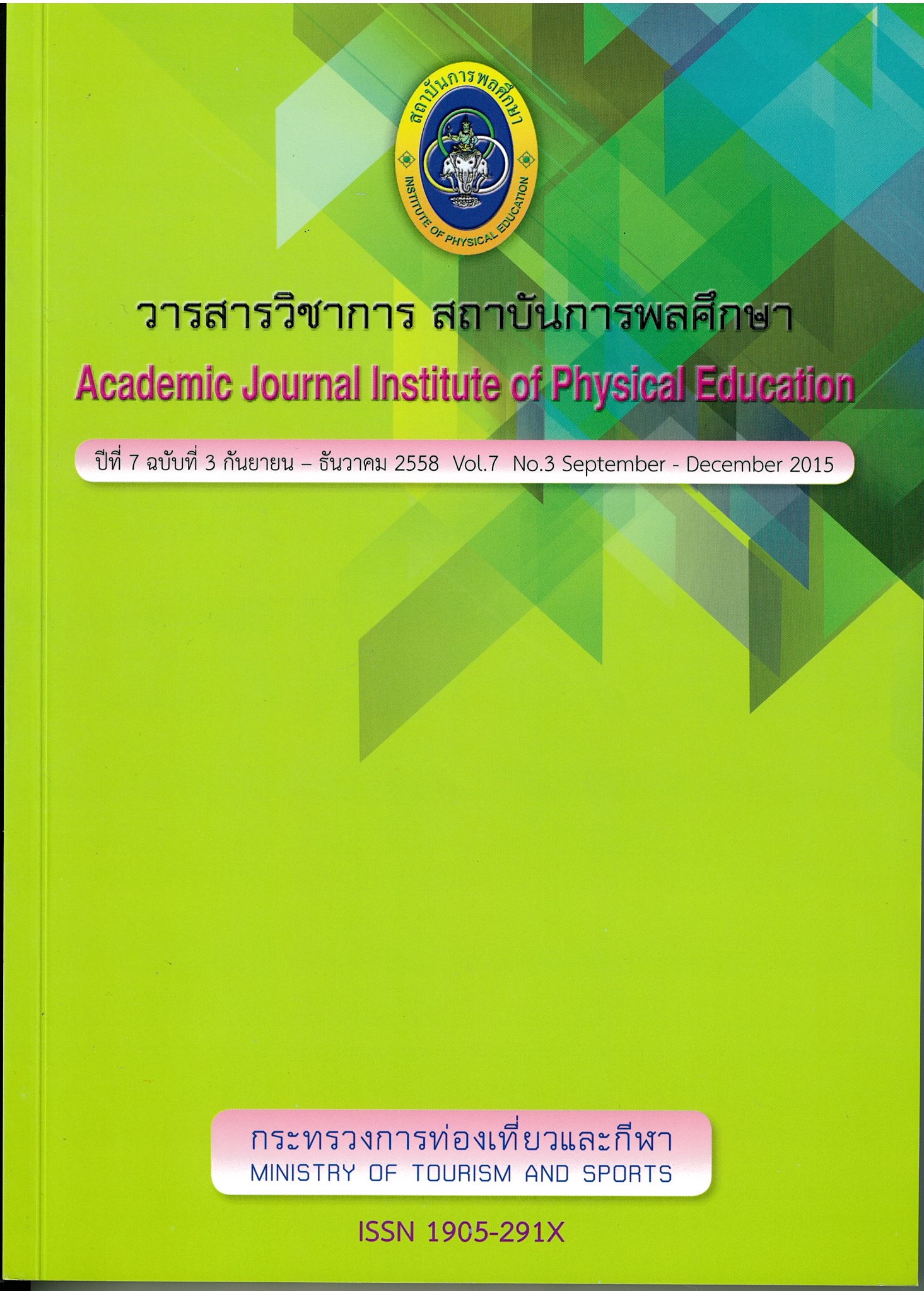The Effect of Combined Speed Ladder and Thai Traditional Game on Agility Speed and Reaction Time in Futsal players
Main Article Content
Abstract
The purpose of this research was to investigate. the effect of combined Ladder and Thai traditional game on agility, speed, and reaction time of the futsal players. The subjects were 30 male futsal players, aged 10-12 years, selected by systematic sampling and equally
divided into 3 groups. The experimental group 1 was trained with Speed ladder program. The experimental group 2 was trained with Thai traditional game program, and the experimental group 3 was trained with combined a Speed ladder and Thai traditional game. They were performed the program for 3 day per week (Monday, Wednesday, and Friday) and 8 weeks convectively. The Agility Speed and the reaction time. Data were collected at pre-training exercise and post training exercise at 4th and 8th week of the training. Data analysis was performed by using one-way ANOVA with Repeated measures and one-way ANOVA multiple comparisons were conducted through Pairwise Comparisons.
The results of this research were as follows. Agility, speed, and reaction time has improved for all experimental groups; however, speed did not find any statistical significant in the experimental groups 3, Those 3 experimental groups showed that physical fitness, agility, speed and reaction time. Has improved after 4 weeks and 8 weeks of training Difference is statistically significant at the .05 level, but not in the Experiment group 3, Among 3 experimental groups, the result of comparison between pre and post experimental training, after 4 weeks and after 8 weeks among 3 groups found that after 4 weeks of training the agility speed of the Experiment group 2 and the Experiment group 3 were significant differences, level .05
Article Details

This work is licensed under a Creative Commons Attribution-NonCommercial-NoDerivatives 4.0 International License.
The published article is a copyright of the Academic Journal of Thailand National Sports University. The passage appeared in each article in this academic journal is a perspective of each author which is not related to the journal. Each author is required to be responsible for all components of his/her own article. If there are any mistakes, each author must be responsible for those mistakes on his/her own.
References
กรมพลศึกษา. (2539), การทดสอบและประเมินผลสมรรถภาพทางกาย. (พิมพ์ครั้งที่ 2) กรุงเทพฯ : โรงพิมพ์ การศาสนา.
กรมพลศึกษา. (2554). ฐานข้อมูลองค์ความรู้ด้านวิทยาศาสตร์การกีฬา (Sport Science) กีฬาฟุตซอล.
เจริญ กระบวนรัตน์. (2548). ความเป็นมาของตาราง 9 ช่องกับการพัฒนาสมอง, ภาควิชาวิทยาศาสตร์, คณะศึกษาศาสตร์, มหาวิทยาลัยเกษตรศาสตร์,
ชัชชัย โกมารทัต. (2549). ความหมายและความสําคัญของกีฬาพื้นเมืองไทย กีฬาพื้นเมืองไทยภาคกลางศึกษา และวิเคราะห์ความเป็นมา วิธีการเล่น และคุณค่า, กรุงเทพฯ : สถาพรบุ๊คส์.
ชุมพล ปานเกตุ. (2540). การฝึกสอนกรีฑาเบื้องต้น กรุงเทพฯ : โอ.เอส.พริ้นติ้งเฮ้าส์.
ชูศักดิ์ เวชแพทย์ และกันยา ปาละวิวัธน์ (2540) สรีรวิทยาการออกกําลังกาย (พิมพ์ครั้งที่ 4), กรุงเทพมหานคร : ธรรกมลการพิมพ์.
ได้ออน ชินธเนศ. (2548). การเรียนรู้ทักษะกลไกการเคลื่อนไหวในวิทยาศาสตร์การกีฬา, กรุงเทพฯ : มีเดียเพรส.
บงการ พรหมผุย. (2545). เอกสารประกอบการสอน “ฟุตซอล” กรุงเทพฯ : ม.ป.พ.
ภัทรธิดา ผลงาม. (2553). ระเบียบวิธีวิจัยทางสังคมศาสตร์ : บทความการเลือกใช้สถิติในการวิเคราะห์ข้อมูล.
ภัทรพนธ์ เหมหงษ์. (2554). ผลการฝึกตารางเก้าช่องและความอ่อนตัวที่มีต่อความคล่องแคล่วว่องไว. วิทยานิพนธ์ปริญญามหาบัณฑิต สาขาวิทยาศาสตร์การกีฬา : มหาวิทยาลัยเกษตรศาสตร์,
ศิริรัตน์ หิรัญรัตน์. (2539), การเสริมสร้างสมรรถภาพทางกายและทางการกีฬา, กรุงเทพฯ : ภาควิชาศัลยศาสตร์ออร์โธปิดิคส์และกายภาพบําบัด คณะแพทย์ศาสตร์ศิริราชพยาบาล มหาวิทยาลัยมหิดล.
สุพล ยะปะภา. (2555). ผลของการฝึกด้วยน้ําหนักตัวเป็นแรงต้านทานและฝึกความเร็วของสเต็ปเท้าด้วยบันไดลิงที่มีต่อความเร็วและความคล่องแคล่วว่องไวของนักกีฬาฟุตซอล, ปริญญานิพนธ์ วทม. สาขาวิชาวิทยาศาสตร์การออกกําลังกายและกีฬา : บัณฑิตมหาวิทยาลัย มหาวิทยาลัยมหาสารคาม,
สมพล สงวนรังสิริกุล. (2546). ข้อเสนอแนะในการออกกําลังกายสําหรับเด็ก (อายุ 2-12 ปี), นนทบุรี : กองออกกําลังกายเพื่อสุขภาพ กรมอนามัย กระทรวงสาธารณสุข.
อาชวิทธิ์ เพิ่งกลิ่นจันทร์. (2552). ผลของโปรแกรมการฝึกความคล่องแคล่วว่องไวแบบผสมผสานการเล่นพื้นเมืองไทยที่มีต่อการพัฒนาความคล่องแคล่วว่องไวของนักกีฬาฟุตบอลอายุระหว่าง 10-12 ปี ปริญญานิพนธ์, วท.ม. (วิทยาศาสตร์การกีฬา), กรุงเทพฯ : บัณฑิตมหาวิทยาลัย มหาวิทยาลัยจุฬาลงกรณ์มหาวิทยาลัย.
Bompa Tudor, O. (1993). Perlodization of strength : New Wave in Strength Training. Toronto: Veritar Publishing.
De vries, H.A. (1980). Physiology of Exercise for Physical Education and Athletes. Wm. New York: C. Brown Company.
Fox E. L. et al. (1993). The Physiological Basis for Exercise and Sport.
Gray M. and Jessica A. (2004). “speed Training Program For High School Football Player," The Sport Journal. 7(1): 128-135; September.
Gabbett, T., and Benton,D., (Jan 2009) Reactive agility of lugby league players. Journal of Science and Medicine in Sport. 12: 212-214.
Marten R. (2004). Successful Coaching. United States : Human Kinetics.
Yong, M.B. macdowrll and Scarlett. (2001) “ The Specific of Speed and Agility," Dissertation Abstract international. 5(2): 315-319; February.
Yong-Jin, Yoon. (July, 1990). The Relationship Between Skill Level in Teakwondo and Selected Measures of Agility and Balance in College Students. Masters Abstracts International. 28 (03): 342


